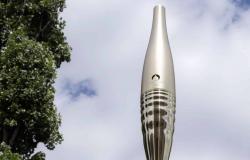Vanity Fair dreamed of it, Helmut Newton did it. In 1992, the willingly provocative photographer, a Berlin Jew forced to flee Nazi Germany in his youth, immortalized on glossy paper Leni Riefenstahl, the sultry muse of the Third Reich who was then celebrating her 90th birthday. The filmmaker had just made a resounding comeback: her Memoirs (1987), translated into English, sold by the thousands, she had just won a harvest of prizes around the world, and was about to offer herself a platform of more than three hours in a documentary by Ray Müller. Her success was such that actress and director Jodie Foster considered adapting and interpreting her life on screen… This return to grace began in the mid-1970s, when her photographic work on the Noubas, populations from the south of the Sudan, was applauded around the world.
The rest under this advertisement
Nature takes its time…
like this ad!
Nature takes its time…
like this ad!
These women bewitched by Hitler
But the seventh art continued to stubbornly close its doors to him. “In the world of cinema, […] she had become radioactive”, comments her American biographer Steven Bach, in Leni Riefenstahl, a German ambition (ed. Actes Sud, 2008). It was not until 2002, on the occasion of his hundredth anniversary, that his documentary Impressions sous-marines was projected on the big screen. The cursed star then undoubtedly believed himself to have been definitively cleared. And her disappearance a year later put an end to the endless litany of defamation suits that she brought against her opponents during her lifetime. But the charges continue to pile up against the most controversial filmmaker in history…
The rest under this advertisement
Nature takes its time…
like this ad!
These films established “a grammar of propaganda”
Born in Berlin in 1902, Helene Riefenstahl was first a dancer, then an actress, before successfully moving on to directing in 1932, with Blue Light, inspired by a tale by the Brothers Grimm. Hitler found a lot of charm in this girl with the look of a bird of prey. Enthusiastic about Mein Kampf, published in 1925, Riefenstahl attended one of its meetings in 1932. She later described an emotional shock: “I had the very physical impression that the Earth was opening in front of me. […]. I felt paralyzed, his speech exerted a real fascination on me.” She sent him a letter, met him on a beach in May 1932 where, she claims, she was forced to reject his advances. Not resentful, Hitler would then have said to him:
The rest under this advertisement
Nature takes its time…
like this ad!
Nature takes its time…
like this ad!
When we are in power, films will have to be made for me.
The rising star of German cinema performed beyond all expectations: his documentaries The Victory of Faith (1933), Freedom Day (1935) and, above all, The Triumph of the Will (1935) exalted to the highest point the strength of Nazism. As for his blockbuster Olympia (1938), filmed in 1936 at the time of the Berlin Olympic Games, it was the heroic showcase of the Third Reich.
These films established “a grammar of propaganda” so effective and so definitive that it is still perfectly discernible in contemporary works of fiction, notes film historian Jérôme Bimbenet in his work Leni Riefenstahl, Hitler’s filmmaker (ed. Tallandier, 2015). In fact, the march of imperial soldiers in Star Wars (1977) by George Lucas, or the ballet of helicopters to the sound of the ride of the Valkyries in Apocalypse Now (1979) by Francis Ford Coppola, owe a lot to his epic settings…
The rest under this advertisement
Nature takes its time…
like this ad!
Hitler’s Bride
In the 1940s, the director set about filming a film adapted from a particularly popular opera by the Führer, Tiefland (“The Lowlands”), the release of which, postponed by the turmoil of war, did not take place. only in 1954. And it was in the posh ski resort of Kitzbühel, in Austria, that she was arrested in the spring of 1945, before being transferred to Germany, near Freiburgen-Brisgau, then under French occupation. The one that the French press frequently presented as “Hitler’s bride”, was subjected to a long procedure aimed at assessing her degree of proximity to the regime. Twice, in December 1948 and in July 1949, the commission of inquiry, supervised by Germans, declared her “not concerned” by the investigative measures. And twice also, the French military government, which administered the French occupation zone, appealed this decision. In December 1949, the commission reclassified Riefenstahl as a Nazi Mitlaüferin (“sympathizer”). Faced with investigators, his defense had been finely crafted. She claimed to have since distanced herself from Hitler and to have suffered the hostility of Joseph Goebbels, the Minister of Propaganda. She further claimed to have never subscribed to anti-Semitic theories nor joined the Nazi party. Another argument: her status as an artist made her a free electron, foreign to politics.
The rest under this advertisement
Nature takes its time…
like this ad!
Nature takes its time…
like this ad!
But over time, this learned edifice was dismantled piece by piece by historians. His weakened ties with Hitler? Not only did the filmmaker never stop seeing the Führer, but she had obtained a multitude of privileges from him, including the privilege of being able to contact him by telephone in his Berlin bunker. As for the thesis of Goebbels’ animosity, it was undermined by the discovery, in Moscow in 1992, of the diary of the Minister of Propaganda.
We discover a man first enchanted, in 1933, by this artist, “the only one of all the stars to understand us”, then impressed by the talent and the grip of “this damn good woman” even if he admitted to being annoyed by his “scenes of hysteria” and his contempt for budgets. In these pages, there is never any question of aversion. When, in 1993, the documentary filmmaker Ray Müller made the remark to a then nonagenarian Rie Fenstahl, she belched in front of the cameras: “Goebbels was the king of lies!”
The rest under this advertisement
Nature takes its time…
like this ad!
If Goebbels was the king, she was the queen. She claimed not to be anti-Semitic, but, without ever falling into doctrinaire hostility, she repeatedly deplored the “omnipotence of the Jews” in pre-war cinema and denounced it. In 1933, the year anti-Semitic violence broke out in Germany, she denounced as Jewish the Hungarian filmmaker Béla Balázs, with whom she had co-directed Blue Light and who demanded money from her for her work… As for her non-membership of the Nazi party, which she used loud and clear for fifty years, is that really an argument?
“Only 5% of German women were members,” recalls Steven Bach. And Riefenstahl established himself so quickly in the Führer’s intimate circle that any membership would have been superfluous. This proximity allowed him to obtain large budgets for his films, notably for Tiefland, one of the most expensive ever made in Germany, almost entirely supported by the Führer’s own funds. Even Olympia did not escape the rule: her masterpiece, acclaimed throughout the world, did not receive subsidies from the Olympic Organizing Committee, as she long claimed, but from the Ministry of Propaganda, led by the man she always presented as her sworn enemy: Goebbels.
The rest under this advertisement
Nature takes its time…
like this ad!
Nature takes its time…
like this ad!
Until the end, she denied having been anti-Semitic and a member of the party
However, the woman who brought propaganda cinema to its incandescent point constantly pleaded for the neutrality of the artist. Better: she claimed to have seen nothing of the atrocities committed by the regime. “Nothing seen,” really? In 1939, she left as a freelance journalist to cover the advance of German troops in Poland. His baptism of fire came on September 12, when 30 to 40 Jewish civilians were massacred before his eyes in Końskie, a small town in the southeast of the country. Until the end, she denied having been there at the time of the events and swore that she had returned to Berlin permanently. Another lie: she joined Hitler in Danzig on September 19, then in Warsaw on October 5, to film the parade of the victorious Reich, assures Jérôme Bimbenet.
The rest under this advertisement
Nature takes its time…
like this ad!
There are still many elements to support. Just after her campaign on the Polish front, the filmmaker continued filming Tiefland, whose story takes place in deep Spain. Due to World War II, the filmmaker moved the theater of operations to the Bavarian Alps. As for the “Mediterranean type” extras, she decided to look for them in a gypsy camp located in Maxglan, on the outskirts of the Austrian city of Salzburg. Except that the camp in question was of a special kind: it was an internment camp guarded by the SS. Twice, in October 1940 and September 1941, the filmmaker in search of “local color” requisitioned Gypsies from the Maxglan camp – 23 prisoners, including 15 children, during the entire shoot. She filmed them under police surveillance, promised to intervene on their behalf… and sent them back where they came from! In 1982, forty years after the events, director Nina Gladitz had survivors testify. Against all evidence, Rie fens tahl maintained that she had recruited her extras from “a welfare camp” and that none of them had died during the war. “By examining the lists, we see that 80% of them were exterminated at Auschwitz,” underlines Nina Gladitz in Michael Kloft’s documentary, Leni Riefenstahl, the end of a myth (Arte, 2020).
The rest under this advertisement
Nature takes its time…
like this ad!
Nature takes its time…
like this ad!
Liar, narcissistic, opportunistic, incapable of the slightest self-criticism, the multi-awarded artist was also a usurper. The brilliant dissolve of Gods of the Stadium (first part of the diptych Olympia) during which Myron’s Discobolus, a famous ancient statue, becomes a living athlete? We owe it to cameraman Willy Zielke. As Michael Kloft’s documentary further reveals, not only did the “star” Rie fens tahl not credit him in the credits, but, taking advantage of Zielke’s weakness, then interned in a psychiatric hospital, she took credit for his photos. and sold them under his own name. The “priestess of beauty”, as she described herself, concealed many darknesses… In 1993, in front of Ray Müller’s camera, Leni Riefenstahl questioned: “I did not throw an atomic bomb, I did not denounced no one! So where is my fault? She died in 2003, at the age of 101. Without remorse or regrets.
The rest under this advertisement
Nature takes its time…
like this ad!
➤ Article published in the GEO History magazine n°74, Nazism and womenfrom March-April 2024.
➤ To see all GEO numbers available individually, click here ! Are you already loyal to GEO content? So to not miss anything, discover our subscription plans to receive GEO at your home each month with ease.






